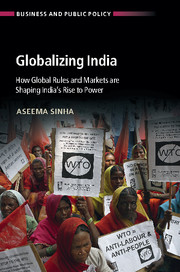Book contents
- Frontmatter
- Dedication
- Contents
- List of figures
- List of tables
- Preface and acknowledgments
- Note on currency translation
- List of abbreviations
- 1 How global rules and markets are shaping India's rise to power
- 2 A theory of causal mechanisms and Global Design-in-Motion
- 3 Trade, statecraft, and state capacity in India
- 4 Realigning interests toward global reach: Changes in India's pharmaceutical sector
- 5 Mobilizing new interests and tying the state's hands: Decline and revival in the textile sector
- 6 Interests in motion: Private sector change in India's textile sector
- 7 Mechanisms of change within global markets
- 8 Conclusion
- Appendix: Field trips, and list of interviews, and libraries visited
- References
- Index
7 - Mechanisms of change within global markets
Published online by Cambridge University Press: 05 April 2016
- Frontmatter
- Dedication
- Contents
- List of figures
- List of tables
- Preface and acknowledgments
- Note on currency translation
- List of abbreviations
- 1 How global rules and markets are shaping India's rise to power
- 2 A theory of causal mechanisms and Global Design-in-Motion
- 3 Trade, statecraft, and state capacity in India
- 4 Realigning interests toward global reach: Changes in India's pharmaceutical sector
- 5 Mobilizing new interests and tying the state's hands: Decline and revival in the textile sector
- 6 Interests in motion: Private sector change in India's textile sector
- 7 Mechanisms of change within global markets
- 8 Conclusion
- Appendix: Field trips, and list of interviews, and libraries visited
- References
- Index
Summary
In the 2000s, the Indian private sector turned away from inward-oriented strategies and sought global reach. Firms accustomed to domestic protections and privileges learned to leverage new skills as well as expand into new markets. Insular Indian businesses started exporting new products into new markets, producing in diverse locations, and investing in wider regions of the world. Indian companies diversified beyond exporting traditional goods, such as gems and jewelry, to manufactured goods and new value-added segments of traditional goods such as garments and technical textiles. These diverse strategies demanded new investment, expansion, and technological modernization, as well as new global alliances. Chapters 4, 5, and 6 documented many such strategies and reorientations across Indian pharmaceutical and textile sectors, where Indian companies were inserted into global supply chains in new ways. The evidence presented in these chapters resonates with a larger body of literature that documents diverse types of internationalization strategies across emerging nations. Yet, we lack a deeper understanding of the distinct mechanisms that change business motivations and strategies. Why and how did internationalization begin among industrial actors that were more acclimated to an environment with domestic protections and privileges? A second, related puzzle is equally compelling: which mechanisms propelled the private sector toward global markets and led it to design strategies of expansion and technological change? Were market-mediated factors (voluntary price-mediated exchange or competition) the primary channels of change in Indian business strategies?
The assertion that globalization strengthens market-mediated behavior is grossly incomplete in that it fails to recognize the pervasive role of nonmarket mechanisms in interaction with market effects. Globalization embodies rules and institutions (constraining elements) that involve legitimate and legal coercion (international standards, for example) as well as the need for public information and learning through cooperative (not merely competitive) means. This effect of global rules in supplementing the power of markets and providing public information to economic actors such as firms and multinationals needs to be analyzed more systematically. This chapter disproves the idea that market-mediated and competition mechanisms alone drove Indian private business forays into the global world. Adopting a microfoundational approach to globalization, I demonstrate the role of distinct nonmarket mechanisms in shaping business responses to a global market. Three such nonmarket mechanisms – public information, learning, and threats – are analyzed with a combination of quantitative and qualitative techniques.
- Type
- Chapter
- Information
- Globalizing IndiaHow Global Rules and Markets are Shaping India's Rise to Power, pp. 237 - 271Publisher: Cambridge University PressPrint publication year: 2016



